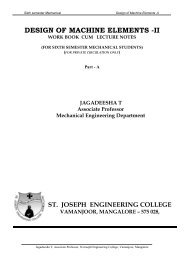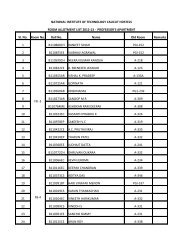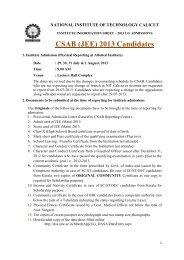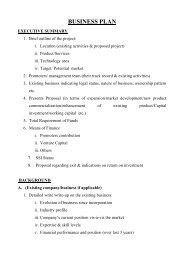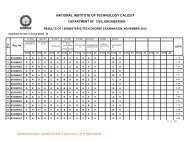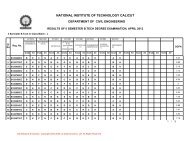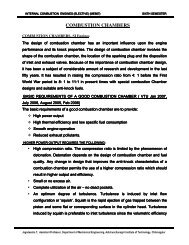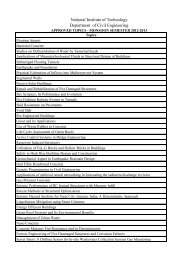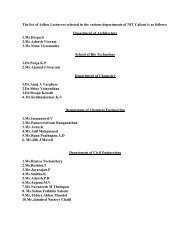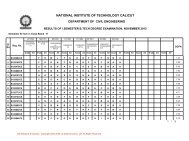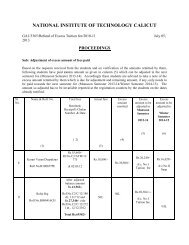combustion process in si engines - National Institute of Technology
combustion process in si engines - National Institute of Technology
combustion process in si engines - National Institute of Technology
Create successful ePaper yourself
Turn your PDF publications into a flip-book with our unique Google optimized e-Paper software.
INTERNAL COMBUSTION ENGINES (ELECTIVE) (ME667)<br />
SIXTH SEMESTER<br />
<strong>process</strong> <strong>in</strong> cyl<strong>in</strong>der. This rapid release <strong>of</strong> energy dur<strong>in</strong>g auto ignition causes a high<br />
pressure differential <strong>in</strong> <strong>combustion</strong> chamber and a high pressure wave is released from<br />
auto ignition region. The motion <strong>of</strong> high pressure compres<strong>si</strong>on waves <strong>in</strong><strong>si</strong>de the cyl<strong>in</strong>der<br />
causes vibration <strong>of</strong> eng<strong>in</strong>e parts and p<strong>in</strong>g<strong>in</strong>g noise and it is known as knock<strong>in</strong>g or<br />
detonation. This pressure frequency or vibration frequency <strong>in</strong> SI eng<strong>in</strong>e can be up to<br />
5000 0 Cycles per second.<br />
Denotation is unde<strong>si</strong>rable as it affects the eng<strong>in</strong>e performance and life, as it abruptly<br />
<strong>in</strong>creases sudden large amount <strong>of</strong> heat energy. It also put a limit on compres<strong>si</strong>on ratio<br />
at which eng<strong>in</strong>e can be operated which directly affects the eng<strong>in</strong>e efficiency and output.<br />
AUTO IGINITION (VTU July 2007)<br />
A mixture <strong>of</strong> fuel and air can react spontaneously and produce heat by chemical<br />
reaction <strong>in</strong> the absence <strong>of</strong> flame to <strong>in</strong>itiate the <strong>combustion</strong> or self-ignition.<br />
This type <strong>of</strong><br />
self-ignition <strong>in</strong> the absence a<br />
<strong>of</strong> flame is known as Auto-Ignition<br />
Ignition. . The temperature at<br />
which the self-ignition takes place is known as self-ignit<strong>in</strong>g temperature. The pressure<br />
and temperature abruptly <strong>in</strong>crease due to auto-ignition because <strong>of</strong> sudden release <strong>of</strong><br />
chemical energy.<br />
This auto-ignition leads to abnormal <strong>combustion</strong> known as detonation which is<br />
unde<strong>si</strong>rable because its bad effect on the eng<strong>in</strong>e performance and life as it abruptly<br />
<strong>in</strong>creases sudden large amount <strong>of</strong> heat energy. In addition to this knock<strong>in</strong>g puts a limit<br />
on the compres<strong>si</strong>on ratio at which an eng<strong>in</strong>e can be operated which directly affects the<br />
eng<strong>in</strong>e efficiency and output.<br />
Jagadeesha T, As<strong>si</strong>stant Pr<strong>of</strong>essor, Department <strong>of</strong> Mechanical Eng<strong>in</strong>eer<strong>in</strong>g, Adichunchanagiri <strong>Institute</strong> <strong>of</strong> <strong>Technology</strong>, Chikmagalur



